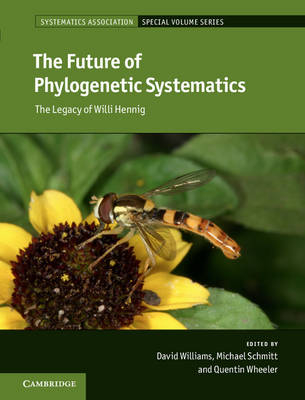
The Future of Phylogenetic Systematics
Cambridge University Press (Verlag)
978-1-107-11764-8 (ISBN)
Willi Hennig (1913–76), founder of phylogenetic systematics, revolutionised our understanding of the relationships among species and their natural classification. An expert on Diptera and fossil insects, Hennig's ideas were applicable to all organisms. He wrote about the science of taxonomy or systematics, refining and promoting discussion of the precise meaning of the term 'relationship', the nature of systematic evidence, and how those matters impinge on a precise understanding of monophyly, paraphyly, and polyphyly. Hennig's contributions are relevant today and are a platform for the future. This book focuses on the intellectual aspects of Hennig's work and gives dimension to the future of the subject in relation to Hennig's foundational contributions to the field of phylogenetic systematics. Suitable for graduate students and academic researchers, this book will also appeal to philosophers and historians interested in the legacy of Willi Hennig.
David Williams is a research scientist at the Natural History Museum, London, specialising in diatom systematics-taxonomy. He has published over two hundred journal papers and has written nine books. His research interests include the systematics and biogeography of diatoms and theoretical studies related to cladistics advances. Michael Schmitt is a retired Adjunct Professor of Zoology at Ernst-Moritz-Arndt-Universität Greifswald, Germany, and was recently appointed President of the German Society for History and Philosophy of Biology. He is the author of From Taxonomy to Phylogenetics: Life and Work of Willi Hennig (2013), the only biography of Willi Hennig. Quentin Wheeler is President of the ESF State University of New York College of Environmental Science and Forestry, Syracuse. He is the author or editor of six books and currently writes a 'New to Nature' feature in the Guardian. His research interests include the morphology, taxonomy and phylogeny of beetles, systematic biology theory, and the role of taxonomy in biodiversity exploration and conservation.
List of contributors; Foreword Norman I. Platnick; Introduction David Williams, Quentin Wheeler and Michael Schmitt; 1. Mission impossible: the childhood and youth of Willi Hennig Willi E. R. Xylander; 2. Willi Hennig: a shy man behind a scientific revolution Michael Schmitt; 3. Willi Hennig's legacy in the Nordic countries Ole Seberg, Torbjørn Ekrem, Jaakko Hyvönen and Per Sundberg; 4. Hennigian systematics in France, a historical approach with a glimpse of sociology Pascal Tassy; 5. Are we all cladists? Andrew V. Z. Brower; 6. How much of Hennig is in present-day cladistics? Michael Schmitt; 7. The evolution of Willi Hennig's phylogenetic considerations Rainer Willmann; 8. What we all learned from Hennig Gareth Nelson; 9. Semaphoronts: 'the elements of biological systematics' Leandro C. S. Assis; 10. Why should cladograms be dichotomous? René Zaragüeta Bagils and Sophie Pécaud; 11. Hennig's auxiliary principle and reciprocal illumination revisited Randall D. Mooi and Anthony C. Gill; 12. Dispersalism and neodispersalism Malte C. Ebach and David M. Williams; 13. Molecular data in systematics: a promise fulfilled, a future beckoning Ward C. Wheeler and Gonzalo Giribet; 14. Hennig, Løvtrup, evolution and biology Robin Bruce; 15. Willi Hennig as Philosopher Olivier Reippel; 16. Hennig and hierarchies Charissa S. Varma; 17. Chain, tree, and network: the development of phylogenetic systematics in the context of genealogical visualization and information graphics Nobuhiro Minaka; 18. The relational view of phylogenetic hypotheses and what it tells us on the phylogeny/classification relation problem Stéphane Prin; 19. This struggle for survival: systematic biology and institutional leadership Quentin Wheeler; Index.
| Erscheinungsdatum | 08.07.2016 |
|---|---|
| Reihe/Serie | Systematics Association Special Volume Series |
| Zusatzinfo | 1 Tables, black and white; 34 Halftones, black and white; 41 Line drawings, black and white |
| Verlagsort | Cambridge |
| Sprache | englisch |
| Maße | 194 x 252 mm |
| Gewicht | 1230 g |
| Themenwelt | Naturwissenschaften ► Biologie ► Evolution |
| Naturwissenschaften ► Biologie ► Genetik / Molekularbiologie | |
| ISBN-10 | 1-107-11764-X / 110711764X |
| ISBN-13 | 978-1-107-11764-8 / 9781107117648 |
| Zustand | Neuware |
| Haben Sie eine Frage zum Produkt? |
aus dem Bereich


